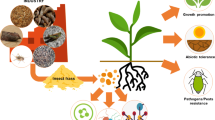Abstract
La possibilité de nourrir la punaiseMacrolophus caliginosus Wagner à l'aide de milieux artificiels a été testée. En l'absence de végétal, les témoins nourris avec des œufs d'Ephestia kuehniella Zeller ont une survie médiocre et fournisent 33% d'adultes. Avec le meilleur milieu artificiel la survie est comparable à celle des témoins et 21 % d'adultes sont obtenus. Avec ce même milieu, mais en présence de feuille de géranium, la production d'adultes atteint 62%. Les compositions en acides aminés des punaises élevées avec le milieu montrent des écarts inférieurs à 20% par rapport aux témoins. Le développement complet deM. caliginosus nourri à l'aide de milieu artificiel a été obtenu. Le végétal joue un rôle important dans la biologie de ce prédateur.
Summary
Different artificial media, offered in small cubic bags, were tested to rearMacrolophus caliginosus Wagner. Without vegetable, the check bugs fed withEphestia kuehniella Zeller [Lep.: Pyralidae] eggs had a poor survival rate and produced 33% of adults. With the best artificial medium, the survival rate is similar to the check and 21% of adults are obtained. With the same medium, but associated withPelargonium leaf, 62% of adults are obtained. The amino acid compositions of bugs reared with the best artificial medium show variations below 20% compared to the checks. The whole development up to a second generation ofM. caliginosus fed with artificial media from the first larval stage was obtained. The vegetable plays a key role in the biology of this predacious bug.
Similar content being viewed by others
Bibliographie
Bonnot, G., Delobel, B. &Grenier, S. — 1976. Composition corporelle en acides aminés du parasitoïdePhryxe caudata Rond. [Diptera, Tachinidae] au cours de sa croissance larvaire. —J. Insect Physiol., 22, 505–514.
Brzezinski, K. — 1982. Report from investigations on morphology, biology and ecology of HeteropteraMacrolophus costalis (Fieb.) [Heterop: Miridae] and its predacity in relation to greenhouse whitefly [Trialeurodes West.]. —Materialy XXIIi.–XXIII Sesji NaukowejIOB., Poznan, 283–292.
Carayon, J. — 1986.Macrolophus caliginosus, Hémiptère Miridae, à reproduction hivernale. —L'Entomologiste, 42, 257–262.
Delobel, B. &Bonnot, G. — 1976. Présence de B alanyltyrosine chez le Diptère TachinairePhryxe caudata Rond. Importance relative des acides aminés libres, peptidiques et protéiques. —Ann. Zool. Ecol. Anim., 8, 493–497.
Dimitrov, A. — 1975. Control of tobacco thrips withMacrolophus caliginosus. —Rastit. Zasch., 23, 34–37 (Rev. Appl. Entomol., Série A, 1976, 64, 619).
Dirimanov, M. & Dimitrov, A. — 1975. Role of useful insects in the control ofThrips tabaci Lind. andMyzodes persicae Sulz. on tobacco. —VIII Int. Plant Prot. Congr.. Moscou, 1975. Section V, 71–72. (Rev. Appl. Entomol., Série A, 1977, 65, 273).
Fauris, C., Danglot, C. &Vilagines, R. — 1981. Mesure de la cytotoxicité des eaux par inhibition de la synthèse d'ARN cellulaire: mise au point d'une microméthode de mesure de la vitesse de synthèse d'ARN cellulaire et domaines d'applications. —Les colloques de l'INSERM, 106, 455–463.
Fauvel, G., Malausa, J. C. &Kaspar, B. — 1988. Etude en laboratoire des principales caractéristiques biologiques deMacrolophus caliginosus [Heteroptera: Miridae]. —Entomophaga, 32, 529–543.
Gomez-Menor, J. M. — 1954. Un mirido que ataca al tomate y al tobaco. —Bol. Pat. Veg. Entomol. Agric., 21, 193–200.
Grenier, S. &Bonnot, G. — 1988. Development ofTrichogramma dendrolimi andT. maidis [Hymenoptera, Trichogrammatidae] in artificial media and artificial host eggs. In:Trichogramma and other egg parasites, 2nd Int. Symposium-Guangzhou, China, 1986. —Les colloques de l'INRA, 43, 319–326.
Khristova, E., Loginova, E. & Petrakieva, S. — 1975.Macrolophus costalis Fiev. Predator of white fly (Trialeurodes vaporariorum Westw.) in greenhouses. —VIII Int. Plant Prot. Congr. Moscou, 1975. Section V, 124–125. (Rev. Appl. Entomol., Série A, 1975, 63, 274).
Author information
Authors and Affiliations
Rights and permissions
About this article
Cite this article
Grenier, S., Guillaud, J., Delobel, B. et al. Nutrition et élevage du prédateur polyphageMacrolophus caliginosus [Heteroptera, Miridae] sur milieux artificiels. Entomophaga 34, 77–86 (1989). https://doi.org/10.1007/BF02372590
Issue Date:
DOI: https://doi.org/10.1007/BF02372590




